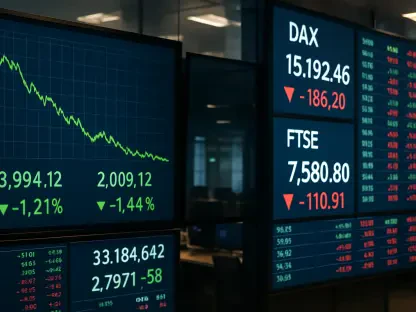Navigating the intricate landscape of the current US stock market involves understanding multiple forces at play, including the volatile relationships between trade policies, market indices, and emerging financial technologies. Key indices like the Dow Jones Industrial Average, S&P 500, and Nasdaq Composite offer glimpses into market health but also reflect the uneasy balance investors must maintain amid fluctuating economic conditions. This balance is further complicated by trade negotiations, Federal Reserve policies, and cryptocurrency’s growing role within traditional financial structures. As investors seek to decipher these complexities, the market’s inherent volatility provides both risks and opportunities.
Trade Tensions and Market Reaction
Impact of US-China Trade Negotiations
The often tumultuous dynamic between the US and China continues to heavily influence stock market behavior. Following a brief but optimistic rally driven by tariff rollbacks, the fleeting optimism sparked concerns about the long-term viability of such measures. Investors, initially buoyed by the agreement’s promise, now face a reality check regarding the persistence of high tariff levels. Market strategists raise alarms about potential overvaluations stemming from misplaced confidence, warning against complacency in believing that the trade tensions have come to an end. As a result, the Federal Reserve has signaled its intention to maintain interest rates until later in the year, adding another layer of complexity to an already intricate economic puzzle.
Market Sentiment and Investor Confidence
Amid these economic uncertainties, maintaining investor confidence proves challenging. Honed negotiating tactics from both nations yield short-term relief but heighten long-term apprehension. As corporations brace for possible trade shocks, many resort to strategic realignments to mitigate adverse impacts. For instance, the impact on the manufacturing sector, primarily reliant on global supply chains, makes business forecasting difficult. Consequently, many are preparing for price fluctuations, pushing experts to adjust forecasts and investors to remain vigilant. The ongoing adaptations highlight how critically sensitive market sentiment is to geopolitical developments, requiring investors to remain ever-ready for rapid shifts in outlook.
Corporate Earnings and Performance
Strategic Adaptations Amid Trade Pressures
The complexities introduced by tariffs have prompted a strategic reevaluation across various industries reliant on international trade. Home Depot’s recent earnings report serves as a potent illustration of these challenges. While revenues soared past predictions, profitability dragged, attributed to lower same-store sales performance. This disparity reflects the fine line businesses tread between maintaining revenue growth and managing costs amid turbulent market conditions. Companies are tasked with reassessing supply chains and distribution networks to offset pressures induced by trade policy shifts. Insights from Home Depot’s approach underscore an industry trend whereby resilience depends not only on revenue figures but also on navigating the subtleties of geopolitical change.
Divergent Impact on the Retail Sector
Faced with similar trade-induced strife, differing retail strategies provide an illuminating glimpse into market adaptation. Walmart’s overt signal of potential price hikes casts a stark contrast to Home Depot’s strategy of maintaining current price levels. Consumers, and subsequently their spending habits, are caught in the crossfire of these pricing decisions, influencing retail confidence and economic outlook. Broader implications ensue as intertwined economic sectors reassess potential ramifications, underscoring the complex ecosystem governing market behavior. As the trade narrative evolves, so too will retailers’ strategies, echoing through industries sensitive to global economic currents.
Federal Reserve Policy
Monetary Policy Under Economic Strain
The Federal Reserve’s leadership remains essential in navigating the US economy in the face of trade and market complexities. Policymakers are tasked with precise economic navigation, assessing interest rate adjustments while balancing external and domestic pressures. Their discussions reveal challenges to price stability stemming from the influence of tariffs on consumer prices. As trade friction escalates, the Federal Reserve finds itself walking a delicate line, attempting to forestall economic deceleration while remaining alert to inflationary threats. This delicate balance foregrounds the complex tapestry of factors that officials must consider when shaping monetary policy, influencing market expectations in the process.
Balancing Economic Growth and Inflation
Economic expansion and inflation are pivotal sustains of market stability, reliant on nuanced policy measures to deter or stimulate financial activity. Federal Reserve officials weigh these factors against inflation benchmarks, seeking equilibrium in the volatile economic landscape. Monetary considerations, underscored by the push-and-pull of rising consumer prices against growth targets, drive thoughtful deliberation. Strategic interpretation of market data informs Fed discussions, illustrating the symbiotic relationship between policy direction and investor response. Through this balancing act, the Federal Reserve’s approach highlights that market interactions are as much about psychology as they are about economic fundamentals.
Cryptocurrency’s Role and Integration
Cryptocurrency’s Growing Influence
The growing convergence between traditional financial systems and cryptocurrency markets stands as a testament to shifting economic dynamics. Digital currency like Bitcoin attracts attention, partially driven by dialogues in the Senate regarding stablecoin regulation. These legislative advancements propose strict requirements for stablecoin issuers, positioning digital currencies alongside traditional financial vehicles in a concerted effort to legitimize the industry. As each regulatory stride enhances cryptocurrency’s legitimacy, these markets not only gain investor trust but also prompt curiosity about their potential role within diversified investment portfolios.
Intersection of Traditional and Digital Finance
High-profile inclusions of cryptocurrency platforms, such as Coinbase, within esteemed indices like the S&P 500 mark a significant nod of acceptance for digital assets. This integration speaks volumes about cryptocurrency’s commercial prospect, adding a layer of credibility to an often-scrutinized financial sector. As investors align with the growing recognition of digital finance, markets brace for shifts brought about by this blend of conventional and emergent economic instruments. With regulatory frameworks evolving and integration deepening, cryptocurrency occupies an ever-expanding space in financial discussions, piquing curiosity and igniting interest from both seasoned investors and newcomers.
Comparative Global Market Perspectives
Divergence in Global Market Performance
Evaluations comparing economic robustness between the US and European stock markets present compelling discourse on regional differences in fiscal performance. Wall Street analysts scrutinize potential European equities surpassing US counterparts, focusing on robust fiscal reforms in countries like Germany. Facilitating steady corporate growth, these reforms highlight opportunities extending beyond traditional US market confines. Economic resilience and promising corporate results garner investor attention, reflecting a trend toward diversification in financial strategies. This broader analysis of global market trajectories encourages strategic international investments, benefiting from financial transformations underway in key European economies.
Strategic Shifts in Investment
The appeal of diversifying investment portfolios beyond US borders aligns with a growing appetite for exploring international opportunities. In light of trade uncertainties and geopolitical shifts, investors target sectors and regions displaying economic fortitude. Germany’s fiscal policies and other favorable conditions entice interest away from domestic prospects, with predictions curating an environment ripe for European equities to outpace their American peers. This strategic focus on global engagement reflects a deeper understanding of interconnected markets, highlighting investors’ yearning for stability amidst potential US turbulence.
Significant Financial Developments
Advances in Electric Vehicle Technology
Amid fluctuating trade and market conditions, standout industries continue to capture investor attention, exemplified by Contemporary Amperex Technology Co.’s (CATL) successful international public offering. Raising substantial capital in a challenging geopolitical climate underscores growing investor recognition of electric vehicle technologies. As global environmental priorities shift, so too does financial backing for sustainable innovations, particularly as reliance on traditional energy sources wanes. Industry expansion, bolstered by high-profile offerings, challenges market apprehensions and sets a precedent for continued growth powered by technological advancements.
Energy Markets and Geopolitical Dynamics
Tradition and innovation intertwine as essential considerations for an evolving energy landscape. Geopolitical negotiations, particularly regarding interactions between countries with powerful economic clout such as the US, Ukraine, and Russia, add layers of complexity to oil markets. Prices reflect these intricate global dynamics, further compounded by external factors influencing market perceptions of security and supply. Navigating this volatile domain requires acute awareness of not only economic forces but also the geopolitical influencers shaping strategic energy dialogues. As the world transitions towards alternative energy solutions, these geopolitical interactions define the contours of future energy market paths.
Insights for Future Developments
Navigating the complex terrain of today’s U.S. stock market requires a nuanced understanding of the various forces in play. Among these are the unpredictable dynamics between trade policies, key market indices, and the rise of new financial technologies. Indices such as the Dow Jones Industrial Average, S&P 500, and Nasdaq Composite serve as barometers of market health. However, they also highlight the delicate balance investors must strike amid ever-changing economic conditions. This balancing act becomes even more challenging due to ongoing trade negotiations, Federal Reserve policies, and the increasing influence of cryptocurrency within traditional financial frameworks.
Cryptocurrencies, once considered a fringe element, now play a significant role in how investors evaluate market trends and opportunities. Meanwhile, trade policies, especially those involving major economies, can abruptly shift market sentiment, impacting investments. The Federal Reserve’s monetary policies, whether through interest rate adjustments or other measures, further add layers of complexity. In this environment, investors are not only looking for gains but also trying to mitigate risks inherent in such a volatile landscape. While the market’s nature presents potential rewards, it equally poses significant threats, demanding an informed and strategic approach to investment.









